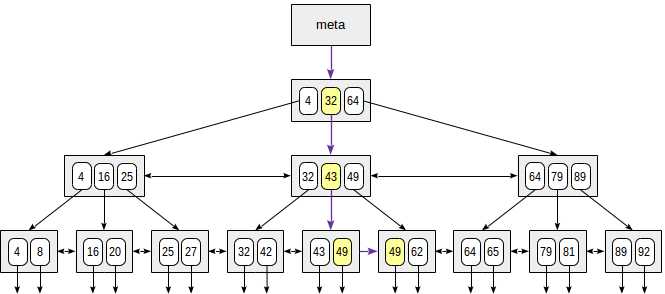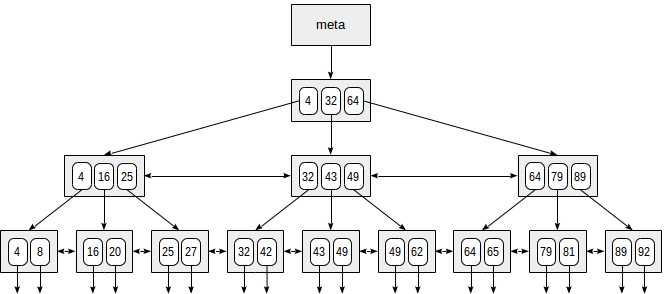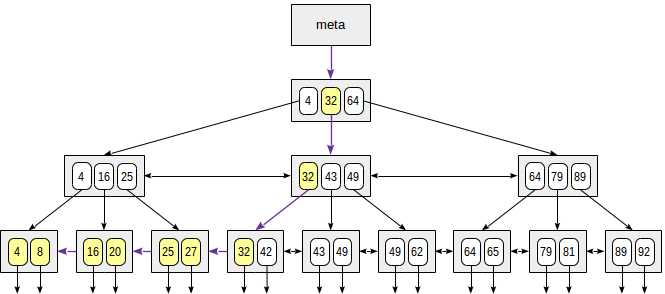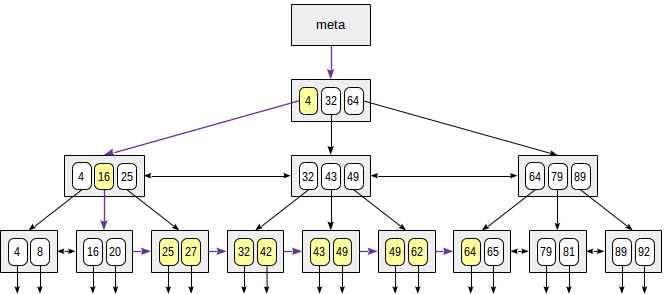PostgreSQL索引(4) – B-tree
本文翻译自Egor Rogov的英文博客,且已征得Egor Rogov的同意。译者做了少量修改。
审校:纪昀红,中国人民大学信息学院在读博士生。
我们已经介绍了PG的通用索引引擎、接口、Hash索引。本文将介绍B-tree,它是最传统、使用最广泛的索引类型。
1. 结构
在PG中,B-tree索引被实现为B-tree AM,它适合可以被排序的数据。也就是说,必须给相应的数据类型定义下面5个操作符:大于、大于等于、等于、小于等于、小于。
B-tree索引的行数据被组织成页面。叶子页面中的行数据,存放的是<key, TID>键值对。非叶子页面中存放的是<minvalue, childptr>键值对,childptr指向本页面的孩子页面(可以是叶子页面,也可是其它非叶子页面),minvalue是子页面中的最小值。
下文也将页面称为节点。
B-tree具有几个重要的特点:
- 它是一颗平衡树。根节点到所有叶子节点的距离都相等,即从根节点到任何叶子节点所经过的非叶节点数量都相等。因此,查找任意的值,需要的时间都相同。
-
它是一颗多叉树。每个节点(通常为8KB的页面)都包含大量(几百个)TID。因此B-tree的高度通常比较小,对一张很大的表来说,高度实际只有4-5层。
-
索引的行数据在索引中以非降序的顺序排列(无论页面内部,还是页面之间),同层的页面之间使用一个双向链表链接起来。因此,我们可以通过直接遍历链表得到有序的数据,而不必每次都访问根页面。
索引文件中的第0页是元页面,它指向根页面。非叶节点在根节点之下,叶节点在最底层。图中向下的箭头表示叶节点中指向基表的TID。
1.1 等值查询
下面介绍使用indexed-field = expression作为条件搜索B-tree的过程。假设被查找的key是49。

查询从根节点开始,然后需要确定向下查找哪个子节点。由根节点中的key可知,应该查询第2个子节点,因为32 ≤ 49 < 64。使用类似的方式,可以找到叶节点,进而找到所需的TID。
实际上,一些特殊情况使这个过程变得很复杂。例如,索引中可能有很多重复值,并且这些重复值不能被容纳到同一个页面中。为了不漏掉某些值,我们必须下降到严格小于49的key所指的孩子节点。即,从小于49的key中,选取最大的一个,下降到这个key指向的孩子节点,遍历这个孩子节点。
查找过程中,索引页面可能会发生分裂,这也使查找过程变得复杂。所有的算法都致力于在这种场景下提高并发。本文不讨论这些内容。
1.2 非等值查询
当使用indexed-field ≤ expression或indexed-field ≥ expression作为条件查询时,我们先找到一个边界值,使它满足indexed-field = expression,然后按照合适的顺序遍历叶子页面即可。
大与和小于的查找过程和上面的过程类似,只需要丢弃边界值即可。
1.3 范围查询
当使用expression1 ≤ indexed-field ≤ expression2作为条件查询时,我们可以先找到expression1,然后按顺序遍历叶子节点,直到indexed-field ≤ expression2不再满足。同理,也可以先找到expression2,然后反向扫描。
下面的示例展示了使用23 ≤ n ≤ 64作为条件的查找过程:
2. 示例
我们看一下查询计划的模样。本文仍然使用上一篇提到的demo数据库,这次给aircraft表建立索引。这个表中只有9行数据,优化器默认不选索引扫描,因为所有的数据都在一个页面中,使用顺序扫描效率最高。但是这张表非常适合用来演示。
select * from aircrafts;
aircraft_code | model | range
---------------+---------------------+-------
773 | Boeing 777-300 | 11100
763 | Boeing 767-300 | 7900
SU9 | Sukhoi SuperJet-100 | 3000
320 | Airbus A320-200 | 5700
321 | Airbus A321-200 | 5600
319 | Airbus A319-100 | 6700
733 | Boeing 737-300 | 4200
CN1 | Cessna 208 Caravan | 1200
CR2 | Bombardier CRJ-200 | 2700
(9 rows)
create index on aircrafts(range);
set enable_seqscan = off;
也可以显式指定索引类型:
create index on aircrafts using btree(range);
等值查询:
explain(costs off) select * from aircrafts where range = 3000;
QUERY PLAN
---------------------------------------------------
Index Scan using aircrafts_range_idx on aircrafts
Index Cond: (range = 3000)
(2 rows)
非等值查询:
explain(costs off) select * from aircrafts where range < 3000;
QUERY PLAN
---------------------------------------------------
Index Scan using aircrafts_range_idx on aircrafts
Index Cond: (range < 3000)
(2 rows)
范围查询:
explain(costs off) select * from aircrafts
where range between 3000 and 5000;
QUERY PLAN
-----------------------------------------------------
Index Scan using aircrafts_range_idx on aircrafts
Index Cond: ((range >= 3000) AND (range <= 5000))
(2 rows)
3. 排序
使用B-tree索引进行Index Scan、Index Only Scan时,可以按顺序返回数据。所以,如果表在排序条件上有索引,优化器有两种选择:1)直接扫描索引,按顺序返回结果;2)顺序扫描,然后对结果进行排序。
3.1 索引列值排序的顺序
在创建索引时,我们可以显式指定排序的顺序,比如:
create index on aircrafts(range desc);
这种情况下,较大的值在树的左边,较小的值在右边。
上文提到,B-tree可以支持正向扫描和反向扫描,显式指定排序方式有什么用呢?
这对多列索引可能有用。
我们首先建立一个视图,它将飞机按续航里程划分为短程、中程、远程三种类型。下文的查询将使用这个视图,以便简化SQL语句。
create view aircrafts_v as
select model,
case
when range < 4000 then 1
when range < 10000 then 2
else 3
end as class
from aircrafts;
select * from aircrafts_v;
model | class
---------------------+-------
Boeing 777-300 | 3
Boeing 767-300 | 2
Sukhoi SuperJet-100 | 1
Airbus A320-200 | 2
Airbus A321-200 | 2
Airbus A319-100 | 2
Boeing 737-300 | 2
Cessna 208 Caravan | 1
Bombardier CRJ-200 | 1
(9 rows)
因为视图中使用了表达式,因此我们建立一个表达式索引:
create index on aircrafts(
(case when range < 4000 then 1
when range < 10000 then 2
else 3 end),
model);
下面对视图中的两列按递增顺序排序,可以看出,这个查询可以使用索引:
select class, model from aircrafts_v order by class, model;
class | model
-------+---------------------
1 | Bombardier CRJ-200
1 | Cessna 208 Caravan
1 | Sukhoi SuperJet-100
2 | Airbus A319-100
2 | Airbus A320-200
2 | Airbus A321-200
2 | Boeing 737-300
2 | Boeing 767-300
3 | Boeing 777-300
(9 rows)
explain(costs off)
select class, model from aircrafts_v order by class, model;
QUERY PLAN
--------------------------------------------------------
Index Scan using aircrafts_case_model_idx on aircrafts
(1 row)
同理,对这两列按递减顺序排序,也可以使用索引:
select class, model from aircrafts_v order by class desc, model desc;
class | model
-------+---------------------
3 | Boeing 777-300
2 | Boeing 767-300
2 | Boeing 737-300
2 | Airbus A321-200
2 | Airbus A320-200
2 | Airbus A319-100
1 | Sukhoi SuperJet-100
1 | Cessna 208 Caravan
1 | Bombardier CRJ-200
(9 rows)
explain(costs off)
select class, model from aircrafts_v order by class desc, model desc;
QUERY PLAN
-----------------------------------------------------------------
Index Scan BACKWARD using aircrafts_case_model_idx on aircrafts
(1 row)
但是,如果对一列按递增顺序排序,对另一列按递减顺序排序,则无法使用这个索引:
explain(costs off)
select class, model from aircrafts_v order by class ASC, model DESC;
QUERY PLAN
-------------------------------------------------
Sort
Sort Key: (CASE ... END), aircrafts.model DESC
-> Seq Scan on aircrafts
(3 rows)
可以看出,虽然禁用了顺序扫描,但是优化器还是选择了顺序扫描。这是因为,所谓的禁用顺序扫描,PG内部仅仅将顺序扫描的代价调高,使得优化器尽量不选顺序扫描,而不是不生成顺序扫描的计划。当没有更优的计划时,即使禁用顺序扫描,优化器仍然会选择顺序扫描。
为了使用索引,必须让索引列按照指定的顺序排序:
create index aircrafts_case_asc_model_desc_idx on aircrafts(
(case
when range < 4000 then 1
when range < 10000 then 2
else 3
end) ASC,
model DESC);
explain(costs off)
select class, model from aircrafts_v order by class ASC, model DESC;
QUERY PLAN
-----------------------------------------------------------------
Index Scan using aircrafts_case_asc_model_desc_idx on aircrafts
(1 row)
3.2 索引定义中列的顺序
多列索引中的值根据下面的方式排序:先比较第一个字段;第一个字段相同时,再比较第二个字段;以此类推。就像对字符串比较大小一样。
在上面的索引中,使用class = 3(仅比较第一个字段)或class = 3 and model = ‘Boeing 777-300’查询索引都会非常高效。
但是当仅使用model = ‘Boeing 777-300’一个条件查询时就会非常低效,优化器在这种情况下,也不会选择索引扫描。因为第一个索引列没有被使用。这并不难理解,在此不再赘述。
如果想让model = ‘Boeing 777-300’条件使用索引,必须在建立索引时调换索引列的顺序:
create index on aircrafts(
model,
(case when range < 4000 then 1 when range < 10000 then 2 else 3 end));
这时,使用model = ‘Boeing 777-300’查询时,效率就会很高。但是仅使用class = 3一个条件查询时效率就低了。
3.3 NULL值
B-tree索引会索引NULL值,并且支持IS NULL和IS NOT NULL作为条件的查询。
例如:
create index on flights(actual_arrival);
explain(costs off) select * from flights where actual_arrival is null;
QUERY PLAN
-------------------------------------------------------
Bitmap Heap Scan on flights
Recheck Cond: (actual_arrival IS NULL)
-> Bitmap Index Scan on flights_actual_arrival_idx
Index Cond: (actual_arrival IS NULL)
(4 rows)
所有的NULL值都在叶子节点的最左端或最右端,这取决于索引是如何创建的(NULLS FIRST还是NULLS LAST)。当查询包含排序时,这很重要:如果查询指定的NULL值的排序方式与索引中NULL的存放方式(NULLS FIRST还是NULLS LAST)一致,则可以使用这个索引。如下所示:
explain(costs off)
select * from flights order by actual_arrival NULLS LAST;
QUERY PLAN
--------------------------------------------------------
Index Scan using flights_actual_arrival_idx on flights
(1 row)
否则,无法使用索引,如下所示:
explain(costs off)
select * from flights order by actual_arrival NULLS FIRST;
QUERY PLAN
----------------------------------------
Sort
Sort Key: actual_arrival NULLS FIRST
-> Seq Scan on flights
(3 rows)
如果想使用索引,必须在建立索引时,将NULL值放在索引的开头:
create index flights_nulls_first_idx on flights(actual_arrival NULLS FIRST);
explain(costs off)
select * from flights order by actual_arrival NULLS FIRST;
QUERY PLAN
-----------------------------------------------------
Index Scan using flights_nulls_first_idx on flights
(1 row)
这一切都是由于NULL值不能参与排序导致的,也就是说,NULL与任何值比较,结果都是未定义的:
\pset null NULL
select null < 42;
?column?
----------
NULL
(1 row)
这违背了B-tree的概念,也不符合通用的规则。但是,NULL值在数据库中扮演着一个非常重要的角色,因此我们经常对它特殊对待。
因为NULL会被索引,所以,表中所有的行在索引中都存在。因此,即使没有任何条件,也可以直接扫描索引。当查询所需的顺序(order by)与索引存放数据的顺序相同时,优化器可能会直接使用索引扫描,而避免额外的排序过程。
4. 属性
我们看一下B-tree索引的属性,查询语句见第二篇文章。
amname | name | pg_indexam_has_property
--------+---------------+-------------------------
B-tree | can_order | t
B-tree | can_unique | t
B-tree | can_multi_col | t
B-tree | can_exclude | t
可以看出,B-tree索引支持排序,并且支持唯一性。它是唯一提供这两个属性的AM。它也支持多列索引(还有其它AM支持多列索引,但不是所有AM都支持)。我们下次再讨论排它约束。
name | pg_index_has_property
---------------+-----------------------
clusterable | t
index_scan | t
bitmap_scan | t
backward_scan | t
B-tree索引既支持索引扫描,也支持位图扫描,而且可以支持正向和反向扫描。
name | pg_index_column_has_property
--------------------+------------------------------
asc | t
desc | f
nulls_first | f
nulls_last | t
orderable | t
distance_orderable | f
returnable | t
search_array | t
search_nulls | t
前4个属性与某列的排序方式有关。本例中,值以升序(非递减)排序,NULL值在最后。也可以采用其它组合。
search_array属性表示它支持下面这种表达式(注意,数组直接被放在索引扫描的扫描条件中):
explain(costs off)
select * from aircrafts where aircraft_code in ('733','763','773');
QUERY PLAN
-----------------------------------------------------------------
Index Scan using aircrafts_pkey on aircrafts
Index Cond: (aircraft_code = ANY ('{733,763,773}'::bpchar[]))
(2 rows)
returnable属性表示它可以被用作Index Only Scan。因为它直接存储了列的值(不像Hash索引一样,存Hash值),而且它还存了NULL值(表中每行数据在索引中都存在)。下面再详细讨论一下covering index的Index Only Scan。
带附属列的唯一索引
像我们之前讨论的一样,一个covering索引存储了查询所需的所有列值,几乎无需扫描基表。一个唯一索引,也可能是一个covering索引。
假设,某个查询需要给一个唯一索引加一列之后,这个索引才能成为这个查询的coving索引。但是如果直接加一列,就破坏了索引在之前列上的唯一性。这时,就需要两个索引,一个索引用来保证唯一性,另外一个索引用来当做covering索引。这当然非常低效。
PG 11支持了一个新特性,索引的INCLUDE特性,它允许在唯一索引上加一些附属的列,这些列不参与唯一性判断,仅仅被Index only scan使用。
示例如下:
\d bookings
Table "bookings.bookings"
Column | Type | Modifiers
--------------+--------------------------+-----------
book_ref | character(6) | not null
book_date | timestamp with time zone | not null
total_amount | numeric(10,2) | not null
Indexes:
"bookings_pkey" PRIMARY KEY, btree (book_ref)
Referenced by:
TABLE "tickets" CONSTRAINT "tickets_book_ref_fkey" FOREIGN KEY (book_ref) REFERENCES bookings(book_ref)
这张表的主键(book_ref, booking code)通过一个常规B-tree实现。我们再创建一个带附属列的唯一索引:
create unique index bookings_pkey2 on bookings(book_ref) INCLUDE (book_date);
然后用新索引代替旧索引(把这些操作放在一个事务中,使得它们同时生效):
begin;
alter table bookings drop constraint bookings_pkey cascade;
alter table bookings add primary key using index bookings_pkey2;
alter table tickets add foreign key (book_ref) references bookings (book_ref);
commit;
结果如下:
\d bookings
Table "bookings.bookings"
Column | Type | Modifiers
--------------+--------------------------+-----------
book_ref | character(6) | not null
book_date | timestamp with time zone | not null
total_amount | numeric(10,2) | not null
Indexes:
"bookings_pkey2" PRIMARY KEY, btree (book_ref) INCLUDE (book_date)
Referenced by:
TABLE "tickets" CONSTRAINT "tickets_book_ref_fkey" FOREIGN KEY (book_ref) REFERENCES bookings(book_ref)
这样,这个唯一索引就可以成为下面查询的covering索引了:
demo=# explain(costs off)
select book_ref, book_date from bookings where book_ref = '059FC4';
QUERY PLAN
--------------------------------------------------
Index Only Scan using bookings_pkey2 on bookings
Index Cond: (book_ref = '059FC4'::bpchar)
(2 rows)
5. 索引的创建
我们知道,对特别大的表来说,最好在建立索引之前,先把数据导入,然后再创建索引。这样,创建索引的速度更快,索引占用的空间更少。
这是因为它使用了一种比单行插入索引更高效的方式。简单来说,就是先把所有数据排序,然后把所有的数据填充到叶子节点,然后再依次建立上层节点,直到根节点。
这个过程的速度受限于内存的大小(maintenance_work_mem参数)。所以,调大这个参数有利于提高建立索引的速度。对唯一索引来说,还要额外多分配work_mem大小的内存。
5.1 比较的语义
上一篇提到,PG需要知道每种类型的数据需要关联那种hash函数。同理,PG需要知道如何对数据进行排序。这对这些操作都有用:order by、group by、meige join等。PG并不依赖操作符的名字(例如>、<、=),因为用户可以定义自己的数据类型,并且可以指定不同的名字。PG使用一个操作符族定义操作符的名字:
例如,这些操作符被bool_ops族使用:
select amop.amopopr::regoperator as opfamily_operator,
amop.amopstrategy
from pg_am am,
pg_opfamily opf,
pg_amop amop
where opf.opfmethod = am.oid
and amop.amopfamily = opf.oid
and am.amname = 'B-tree'
and opf.opfname = 'bool_ops'
order by amopstrategy;
opfamily_operator | amopstrategy
---------------------+--------------
<(boolean,boolean) | 1
<=(boolean,boolean) | 2
=(boolean,boolean) | 3
>=(boolean,boolean) | 4
>(boolean,boolean) | 5
(5 rows)
我们看到,有5个操作符,再次强调,不要依赖它们的名字。为了说明每个操作符做何种比较操作,PG引入了策略的概念。5种策略分别描述上面5个操作符的语义:
1 — less
2 — less or equal
3 — equal
4 — greater or equal
5 — greater
某些操作符族包含很多实现同一种策略的操作符。例如,integer_ops族包含了这么多实现策略1的操作符:
select amop.amopopr::regoperator as opfamily_operator
from pg_am am,
pg_opfamily opf,
pg_amop amop
where opf.opfmethod = am.oid
and amop.amopfamily = opf.oid
and am.amname = 'btree'
and opf.opfname = 'integer_ops'
and amop.amopstrategy = 1
order by opfamily_operator;
opfamily_operator
----------------------
<(integer,bigint)
<(smallint,smallint)
<(integer,integer)
<(bigint,bigint)
<(bigint,integer)
<(smallint,integer)
<(integer,smallint)
<(smallint,bigint)
<(bigint,smallint)
(9 rows)
由于有这些操作符,PG可以在比较不同数据类型时避免类型转换。
5.2 支持新的数据类型
PG官方文档中提供了一个创建新的数据类型,并且创建新操作符类让它支持排序的例子。这个例子用C语义完成,这在性能关键的场景下非常有用。但这并不阻碍我们使用纯sql语言完成同样的实验,以便更好的理解比较的语义。
首先创建一个复数类型,它包含两个字段:实部和虚部。
create type complex as (re float, im float);
使用这个新的数据类型创建一张表,并且插入一些数据:
create table numbers(x complex);
insert into numbers values ((0.0, 10.0)), ((1.0, 3.0)), ((1.0, 1.0));
问题来了,如果没有数学定义的话,如何对这些复数进行排序呢?
其实,PG已经为我们定义了默认的比较操作符:
select * from numbers order by x;
x
--------
(0,10)
(1,1)
(1,3)
(3 rows)
默认情况下,对一个复杂数据类型排序时:首先比较第一个字段,然后第二个字段,以此类推,就像字符串比较一样。但是,我们也可以定义不同的排序方式。例如,复数可以被看成是向量,我们可以按照向量的模(长度)排序。首先,根据勾股定理,定义下面的辅助函数,它可以计算出复数的模:
create function modulus(a complex) returns float as $$
select sqrt(a.re*a.re + a.im*a.im);
$$ immutable language sql;
现在我们使用辅助函数,依次定义5个函数。
create function complex_lt(a complex, b complex) returns boolean as $$
select modulus(a) < modulus(b);
$$ immutable language sql;
create function complex_le(a complex, b complex) returns boolean as $$
select modulus(a) <= modulus(b);
$$ immutable language sql;
create function complex_eq(a complex, b complex) returns boolean as $$
select modulus(a) = modulus(b);
$$ immutable language sql;
create function complex_ge(a complex, b complex) returns boolean as $$
select modulus(a) >= modulus(b);
$$ immutable language sql;
create function complex_gt(a complex, b complex) returns boolean as $$
select modulus(a) > modulus(b);
$$ immutable language sql;
然后,定义5个操作符。为了演示,我们故意不把它们叫做”<“或”>”,我们随意给他们起一些名字:
create operator #<#(leftarg=complex, rightarg=complex, procedure=complex_lt);
create operator #<=#(leftarg=complex, rightarg=complex, procedure=complex_le);
create operator #=#(leftarg=complex, rightarg=complex, procedure=complex_eq);
create operator #>=#(leftarg=complex, rightarg=complex, procedure=complex_ge);
create operator #>#(leftarg=complex, rightarg=complex, procedure=complex_gt);
这时,我们就可以用这些操作符比较复数了:
select (1.0,1.0)::complex #<# (1.0,3.0)::complex;
?column?
----------
t
(1 row)
除了5个操作符之外,B-tree AM还需要另外一个函数:如果第一个参数 < 第二个参数,它必须返回-1;如果第一个参数 = 第二个参数,它必须返回0;如果第一个参数 > 第二个参数,它必须返回1。这个函数被称作support函数。其它AM可能需要定义其它support函数。
create function complex_cmp(a complex, b complex) returns integer as $$
select case when modulus(a) < modulus(b) then -1
when modulus(a) > modulus(b) then 1
else 0
end;
$$ language sql;
现在,我们可以定义一个操作符类(同名的操作符族会被自动创建):
create operator class complex_ops
default for type complex
using B-tree as
operator 1 #<#,
operator 2 #<=#,
operator 3 #=#,
operator 4 #>=#,
operator 5 #>#,
function 1 complex_cmp(complex,complex);
现在,查询默认就用这个操作符类进行排序了:
select * from numbers order by x;
x
--------
(1,1)
(1,3)
(0,10)
(3 rows)
这些函数也支持B-tree。
我们可以使用这个语句查询support函数:
select amp.amprocnum,
amp.amproc,
amp.amproclefttype::regtype,
amp.amprocrighttype::regtype
from pg_opfamily opf,
pg_am am,
pg_amproc amp
where opf.opfname = 'complex_ops'
and opf.opfmethod = am.oid
and am.amname = 'B-tree'
and amp.amprocfamily = opf.oid;
amprocnum | amproc | amproclefttype | amprocrighttype
-----------+-------------+----------------+-----------------
1 | complex_cmp | complex | complex
(1 row)
6. 索引页面的物理构造
我们可以使用pageinspect插件查看B-tree页面的内容。
create extension pageinspect;
元页面:
select * from bt_metap('ticket_flights_pkey');
magic | version | root | level | fastroot | fastlevel
--------+---------+------+-------+----------+-----------
340322 | 2 | 164 | 2 | 164 | 2
(1 row)
请注意level列:在一百万行的表上,对两个列建立所以,索引的高度只有2(不包含根页)。
第164页(root)上的统计信息:
select type, live_items, dead_items, avg_item_size, page_size, free_size
from bt_page_stats('ticket_flights_pkey',164);
type | live_items | dead_items | avg_item_size | page_size | free_size
------+------------+------------+---------------+-----------+-----------
r | 33 | 0 | 31 | 8192 | 6984
(1 row)
块中的数据:(data列, 受限于屏幕大小,将其截断,它包含了索引的数据,以16进制显示):
select itemoffset, ctid, itemlen, left(data,56) as data
from bt_page_items('ticket_flights_pkey',164) limit 5;
itemoffset | ctid | itemlen | data
------------+---------+---------+----------------------------------------------------------
1 | (3,1) | 8 |
2 | (163,1) | 32 | 1d 30 30 30 35 34 33 32 33 30 35 37 37 31 00 00 ff 5f 00
3 | (323,1) | 32 | 1d 30 30 30 35 34 33 32 34 32 33 36 36 32 00 00 4f 78 00
4 | (482,1) | 32 | 1d 30 30 30 35 34 33 32 35 33 30 38 39 33 00 00 4d 1e 00
5 | (641,1) | 32 | 1d 30 30 30 35 34 33 32 36 35 35 37 38 35 00 00 2b 09 00
(5 rows)
第一条元组中data为空,表示负无穷大(参见PG文档)。这个页面的孩子页面分别为block 3、163、323、482、641。
可以查阅PG的文档、README和源代码,了解更多内容。
PG 10 中另外一个有用的插件是amcheck。它可以检查B-tree索引中的逻辑一致性,使得我们可以事前检测到错误。




